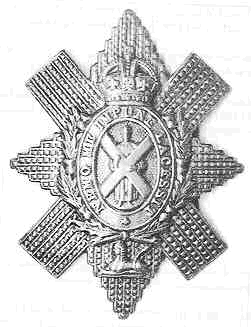

BAWTREE, David Edward
Private 293008
BLACK WATCH (Royal Highlanders), 6th (Perthshire) Battalion
153rd BRIGADE
51ST (HIGHLAND) DIVISION
TERRITORIAL FORCES
Died Saturday, 29th June 1918. Aged 23
Born Colchester
Son of William J. Edgeworth Bawtree and Blanche R. Bawtree, of Argyle House, Whitton Park, Hounslow, Middlesex.
The Bawtree Family were for 3 generations, one of the major land owning families in Abberton. They lived at Abberton Manor and were significant financial supporters of Saint Andrew's Church. David's grandfather was one of the major benefactors during the 1870s. David was christened by the Reverend Gunter in Saint Andrew's on the 16th August 1894. David's father, William was the youngest son and was living in Colchester when David was born.
There are a number of family graves on the North side of the grave yard by the wicket gate, these include David's parents, grandparents, aunts and uncles plus there are memorials on the Church walls. David's grandfather died in1898. David's father died 6th May 1908 and is buried with his mother, who survived till 9th May 1948 when she died aged 74.
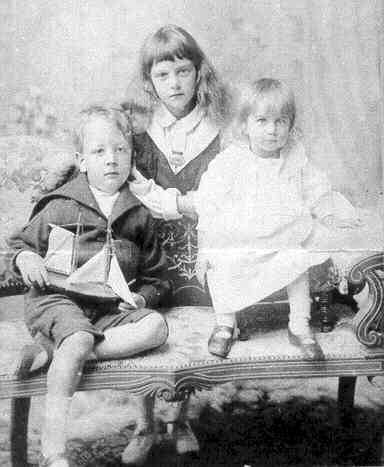
A picture of David as a child with his sisters Winnie & Maisie
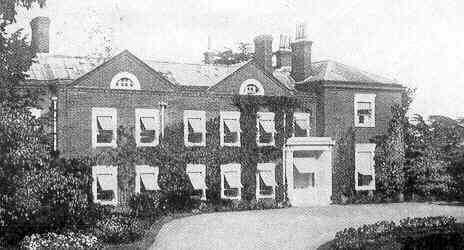
Abberton Manor in 1910. This was the home of David's Grandfather.
David left the Colchester Royal Grammar School in 1912. He was living at 11 St. Lucas Road, Bayswater, when he enlisted at Twickenham. . His actual Service records are missing. He was wounded and on his recovery rejoined again, this time in the Black Watch. He had numbers of 6124 & then 6871 in the early part of the war. The records of the Battalion these relate to are lost. From his subsequent Service number, 293008, it can be deduced that this would have been given in 1917. He is shown as enlisting in the 6th Battalion (1), The Black Watch, which was a Territorial Unit.
The 6th Battalion had landed in France on the 2nd May 1915. During 1915 they had been engaged in Trench warfare at :_ Festubert, Le Touret, Fauquissart, La Boisselle, Authuille and Ovilliers during May to December.
Trench warfare continued during January to July 1916 at :_ Maricourt, Maison Blanche, Neuville St. Vaast and Maroeuil.
The Battle of Bazentin Ridge (High Wood) involved the 6th on the 22nd July. Immediately afterwards, they were involved in the Battle of Pozieres Ridge on the 30th -31st July. Activity then reverted to Trench warfare between August and November at Houplines, Armentieres Sector, Hebuterne and Beaumont Hamel. This lead to the Battle of Beaumont Hamel on the 13th -14th November. The year ended with November and December devoted to Trench warfare at Aveluy and Pys.
January through April 1917 was continued Trench warfare at Pys, Ecurie, Rolincourt and Fampoux. The 6th were then involved in the First Battle of Scarpe (Ecurie) on 9th April and the Second Battle of Scarpe (Rouex) on the 23rd- 24th April. Trench warfare was their lot through April - July at :- Rouex, Chemical Works, Ypres and Lancashire Farm.
The 6th were involved in the Battle of Picklem Ridge (Steenbeck) on the 31st July and 1st August. They then reverted to Trench warfare again through August - November :- Ypres, Langemarck, Canal Bank, and Cherisy. This was followed on 20th -21st November with the Battle of Cambrai (Grand Ravine and Flesquieres). The balance of the year, they were in the Line involved in the usual Trench warfare at Longueval and Louveral.
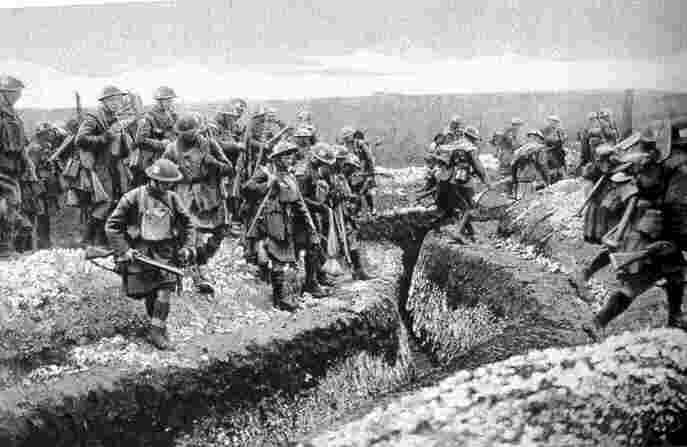
Highland Territorials jumping a German trench when attacking on the Cambrai front.
January - March 1918 was devoted to Trench warfare at Louveral and Pronville. The 6th were then involved in the 1st Battle of Baupaume (Beaumetz, Rancourt) on the 21st-25th March. Followed by the Battle of The Lys (Battle of Estaires) on 9th April.
The circumstances of Edward's death are not clear. It is possible he was captured in one of the many actions the Black Watch distinguished themselves in, either in 1917 or more probably during the German offensive in early 1918. He probably then succumbed to wounds, as the graveyard contains many POWs and was next to a German hospital (2).
The 6th Battalion was severely mauled in the German offensive starting March 18th 1918 at Arras. Both the 6th Battalion and 7th were similarly hard pressed at Cambrai .
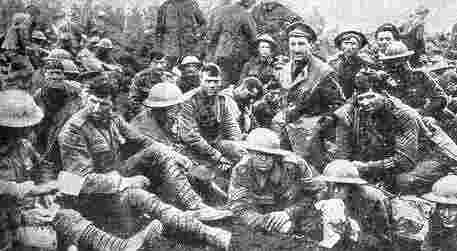
The above picture is taken from a contemporary German newspaper and shows British POWs captured during the 1918 German Spring Campaign.
David earned the British War Medal and the Allied Victory Medal. The fact his record does not include the 1914- 15 Star indicates he went overseas for the first time after 1916.
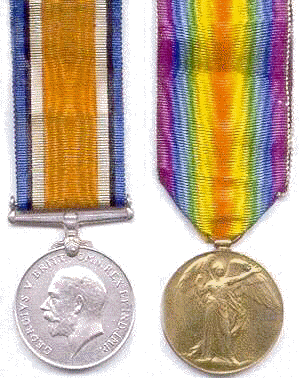
He is commemorated in Denain in France, on the Memorial of Colchester Royal Grammar School and on the War Memorial in Colchester Town Hall.
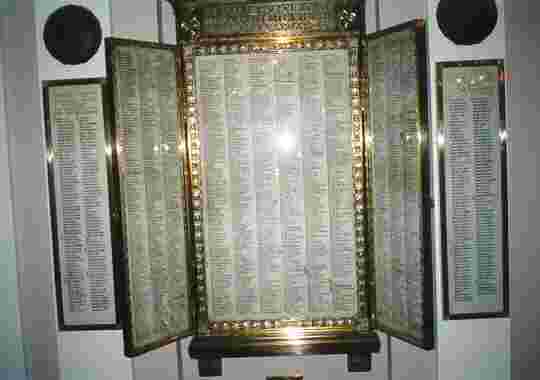
He is also listed on the Black Watch Memorial at Edinburgh Castle.
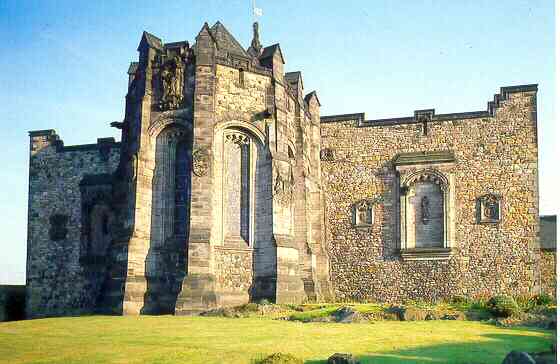
The Apse of the Scottish National War Memorial
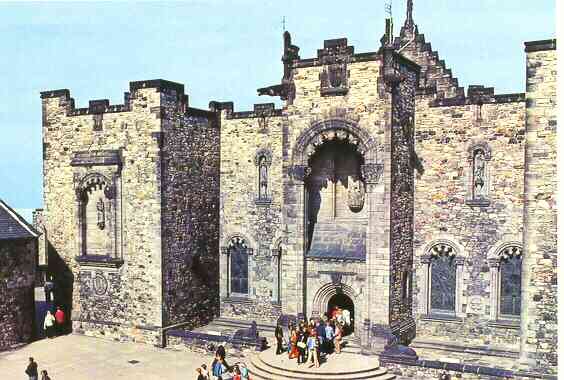
The entrance to the Scottish National War Museum. Inside are a series of memorial panels devoted to each Scottish Regiment including, The Black Watch. A tour of the inside may be seen by clicking on:-
The Black Watch Memorial is in the Hall of Honour looking West.
David is buried in DENAIN COMMUNAL CEMETERY, NORD, FRANCE in grave D 56.
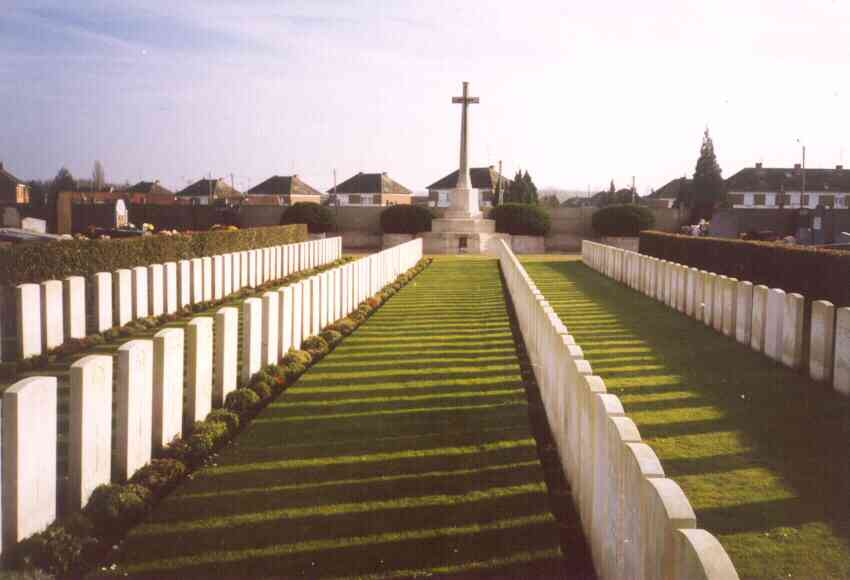
Denain is a town in the Department of the Nord, next to Valenciennes on the road and motorway towards Cambrai. The Communal Cemetery is situated in the north-east corner of the town approximately 1.2 kilometres from the town centre on the D40, following the route to Oisy and the Lycee A Kastler. The cemetery will be found at the centre of a junction 20 metres from a traffic light controlled crossroads (D40 &D60). The Commonwealth War Grave Commission plot will be found in the centre of the cemetery.
Denain was a German hospital centre during the greater part of the War; and from the 1st November, 1918, to the 12th March, 1919, the 33rd Casualty Clearing Station was posted in the town. The Communal Cemetery, was used by the Germans to bury their soldiers and (in 1917 & 1918) 153 British prisoners. A British plot was made at the South- East end, after the capture of the town; and after the Armistice the graves were regrouped beside it. There are now over 300, 1914 - 1918 war casualties commemorated in this site. The British plot covers an area of 777 square metres.
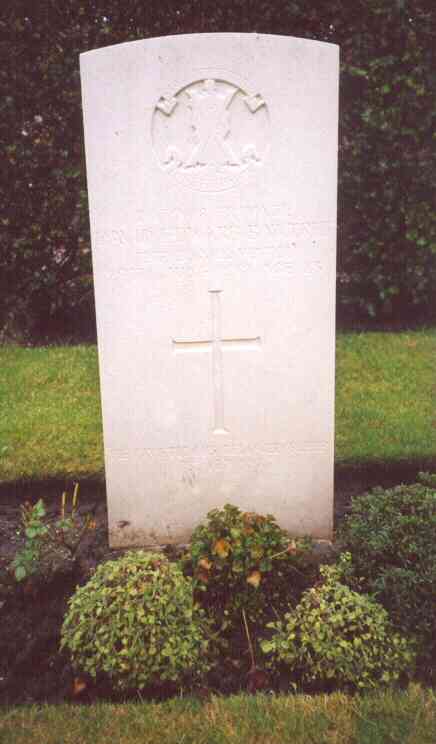
notes :-(1)The "
Soldiers Died in the Great War, part 46 The Black Watch page 40 column 1 shows the 6th Battalion, though the CWG show the 4th Battalion. However, no other evidence for the 4th can be found. His records are not held at the PRO at Kew. Information obtained from The Commonwealth War Graves web site. www.cwgc.org/ regarding his grave.Information on the 6th Battalion is from "A History of the Black Watch in the Great War" by E.A.G.Wauchope London Medici Society 1925-26 3 volumes on the Chronology of the 6th, from volume II pages 234-5. This material was kindly researched by the Black Watch Museum.
(2). Since the location was close to the Front, it suggests he had only recently been captured, otherwise presumably he would have been shipped to a camp back in Germany.
The pictures of the war are from "The Great War - The Standard History of the all- Europe conflict" The picture of Abberton Manor is from a post card collection formerly owned by the late May Harrison The pictures of The Scottish National War Museum are reproduced with the kind permission of the Trustees of the Scottish National War Museum. 02/05/03 last updated
**********************************************************
These pages are dedicated to the memory of the Fallen from the two World Wars, who lived in Abberton & Langenhoe.. Prepared by Saint Andrew's Parochial Church Council. November 11th 2000